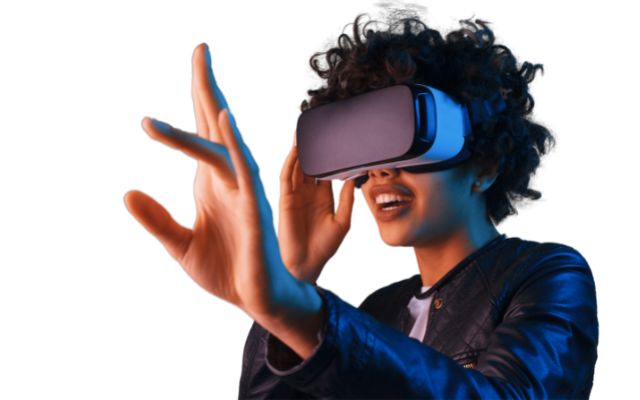How to Use Virtual Reality in Business: A Guide for Companies

Virtual Reality in Business- Virtual Reality (VR) is rapidly becoming an essential tool for businesses. It offers a unique way to showcase products, simulate real-world scenarios, and create immersive experiences for customers and employees alike. Here’s a guide for companies on how to use VR effectively in their business:
How to Use Virtual Reality in Business
- Determine the goal and target audience: Define the objective of using VR and understand who the target audience is. It could be for product demonstrations, employee training, or customer engagement.
- Develop a VR strategy: Plan how you intend to use VR in your business. Will you develop your VR application or use existing software? What equipment will be required? Will it be for in-house or public use?
- Choose the right VR hardware: Selecting the right VR hardware is essential to achieve the desired results. A high-end VR headset may be required for detailed product demonstrations, whereas a lower-end headset can be suitable for training.
- Create the VR content: Develop immersive VR content that aligns with the defined goal and audience. Whether it is product demos, simulations, or training, the content must be engaging and informative.
- Implement and test: Integrate VR into the business environment and test it with a small group of users. Gather feedback and make necessary changes to ensure a successful implementation.
- Promote and publicize: Once VR is integrated into the business, publicize it through various channels such as social media, website, or marketing campaigns.
- Maintain and update: Keep the VR content updated and maintain the equipment to ensure optimal performance and customer experience.
What is VR for business?
Virtual Reality (VR) for business refers to the use of VR technology and content to enhance and streamline various aspects of business operations, including product development, employee training, customer engagement, and marketing. It allows companies to create immersive and interactive experiences that help improve productivity, reduce costs, and boost customer satisfaction.
With VR, businesses can provide more engaging and effective training for their employees, showcase products in an innovative way, and create memorable experiences that drive customer engagement and loyalty. Overall, VR for business is a powerful tool that enables companies to stay ahead of the curve and deliver superior experiences to their employees and customers.
The difference between virtual, augmented, mixed, and extended reality
Virtual, Augmented, Mixed, and Extended Reality are all related to the use of computer-generated environments to create immersive experiences for users. However, each of them differs in terms of the level of immersion, the degree of interactivity, and the way they blend the virtual and physical worlds.
- Virtual Reality (VR): Virtual Reality is a fully immersive experience that uses a headset or other display device to create a completely computer-generated environment. Users can interact with the virtual world and feel like they are in a different place altogether. VR is commonly used for gaming, simulations, training, and virtual travel experiences.
- Augmented Reality (AR): Augmented Reality overlays digital content onto the physical world. It enhances the user’s real-world environment with computer-generated graphics, sounds, or haptic feedback. AR is commonly used in mobile apps and games, product demos, and marketing campaigns.
- Mixed Reality (MR): Mixed Reality blends the virtual and real worlds, creating an environment in which digital content interacts with the physical world. MR devices such as the Microsoft HoloLens or Magic Leap use sensors to map the physical environment and place virtual objects in that space. MR is commonly used for product design, prototyping, and construction.
- Extended Reality (XR): Extended Reality is an umbrella term that covers all immersive technologies, including VR, AR, and MR. It also includes other technologies that combine real and virtual environments, such as haptic feedback and brain-computer interfaces. XR is commonly used for gaming, training, and simulation applications.
Virtual Reality (VR) can be used by businesses in many different industries and for a wide variety of purposes. Here are some common business use cases for VR:
- Architecture, Engineering, and Construction (AEC): VR can be used in the AEC industry for design visualization, collaboration, and simulation. It enables architects, engineers, and construction professionals to create virtual models of buildings, test them in a simulated environment, and collaborate with team members and clients.
- Manufacturing: VR can be used in manufacturing to create virtual simulations of production processes and to train employees on how to use equipment or machinery in a safe and controlled environment.
- Retail: VR can be used in retail to create virtual showrooms or stores where customers can browse and purchase products in a virtual environment. It can also be used for virtual product demonstrations and training for sales associates.
- Healthcare: VR can be used in healthcare for medical training, patient education, and pain management. It can provide a safe and controlled environment for medical professionals to practice procedures and for patients to undergo therapy or distraction during medical procedures.
- Education and Training: VR can be used for employee training, education, and development across a wide range of industries. It provides a highly engaging and immersive learning experience that can improve retention and performance.
Overall, VR can be used by any business that wants to create engaging and immersive experiences for its customers or employees, or that wants to improve its operations through simulation, collaboration, or training.
- 10 Free Apps and Games to Play on Your New VR Headset
- Apples AR/VR Headset Launches in Early 2022
- Amazing Pimax Next Gen 12K QLED VR Headset
Conclusion
VR can provide businesses with a unique and immersive way to showcase their products and services, train employees, and engage customers. By following the above guide, companies can leverage the full potential of VR and stay ahead of the competition.






